Three shifts to help organizations navigate a post-pandemic future
(Sponsored content by Pigott, provided by Herman Miller. All images from Herman Miller)
The leveling effect of a global pandemic touches every aspect of life: home, work, and all the places in between. At Herman Miller, we believe that problem-solving, human-centered design means supporting people wherever they are. Once organizations acknowledge that work can happen anywhere, the goal becomes finding ways to best support people at home, in the office, and beyond—with an understanding that workers may seek out each spot for different reasons.
From our perspective, this widespread openness to change is exciting. We’ve identified three of the most important shifts that workplaces everywhere must make to remain relevant. When you’re ready to explore further, we’ll be there to help you augment your workplace strategy with products, settings, and programs to help your people do their best work—wherever they choose to do it.

SHIFT 01
From forced acceptance to strategic advantage
How a hybrid strategy promotes inclusivity and equity of experience
This so-called “hybrid strategy” presents organizations with an opportunity to holistically address the needs of a highly diverse workforce with a focus on equity of experience. This means considering the needs of remote team members as well as their colleagues in the office. A myriad of factors can affect an individual’s productivity and engagement—everything from work styles, location of colleagues, and project deadlines to home office conditions, parenting responsibilities, and physical/sensory needs. And these factors are not fixed; they can change from day to day or week to week.
By trusting employees to make choices based on their daily tasks and preferences—with support whether they choose to come into the office or work from home—organizations can reshape the office into a sought-after destination for those social and cultural connections that cannot be recreated virtually.
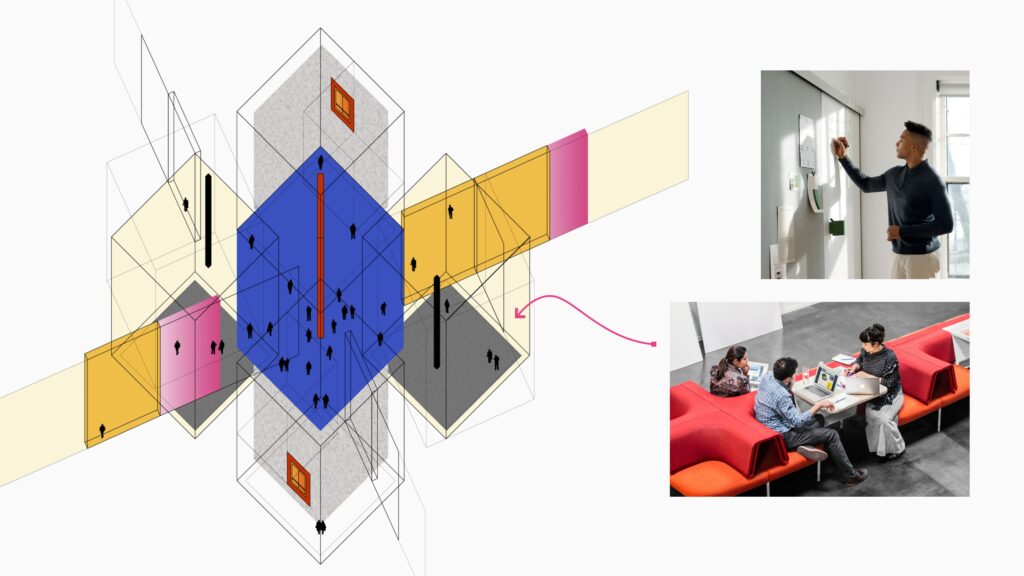
SHIFT 02
From substantial expense to competitive edge
Reorienting office space around three activities not supported elsewhere
Even before the pandemic, offices were struggling to consistently support people and their work. For many organizations, the physical office didn’t keep pace: It was often generic and too densely planned, while deprioritizing remote work. However, when given a choice, many employees had already begun working from home, coworking spaces, cafés, or elsewhere. As we look to the future, we see an opportunity to reorient the office so that workers feel less anchored to it and more buoyed by it, as facilities focus on hosting experiences that the isolation of the pandemic robbed from us all.
What can organizations do to make their spaces more desirable as on-demand destinations for employees newly empowered to work anywhere? From data provided by more than 19,000 users of Herman Miller’s WFH Ergonomic Assessment tool 3 and other sources, we have identified three core experiences that the office is uniquely positioned to support. At Herman Miller, we’re focused on helping customers evolve existing environments with products and settings specifically designed with these experiences in mind.
Three core experiences best supported by the office
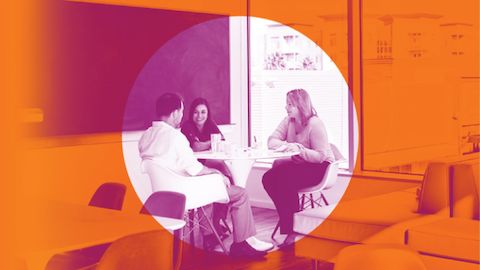
Community socialization
Building these relationships is also critical for establishing and maintaining culture—and helping people feel a sense of purpose and belonging. By providing areas that encourage people to interact with their extended networks, your office can help reestablish these connections.
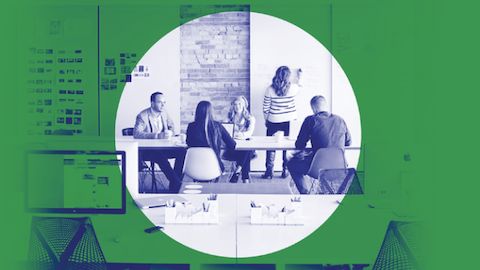
Team collaboration
When workplaces practice neighborhooding in this way, they better accommodate longer-term collaboration while also creating opportunities for those spur-of-the-moment chats that cannot be scheduled via videoconference.

Individual focus
The past year has stressed our homes in many ways, with spare bedrooms called into duty as classrooms, gyms, offices, or all the above. And for those of us without a room to spare, the realities of children, roommates, or extended family have made it difficult to even find a corner to work in—let alone actually finding focus. For these individuals, a return to the physical office can provide a respite for concentration and focused work, given the right spatial setup.
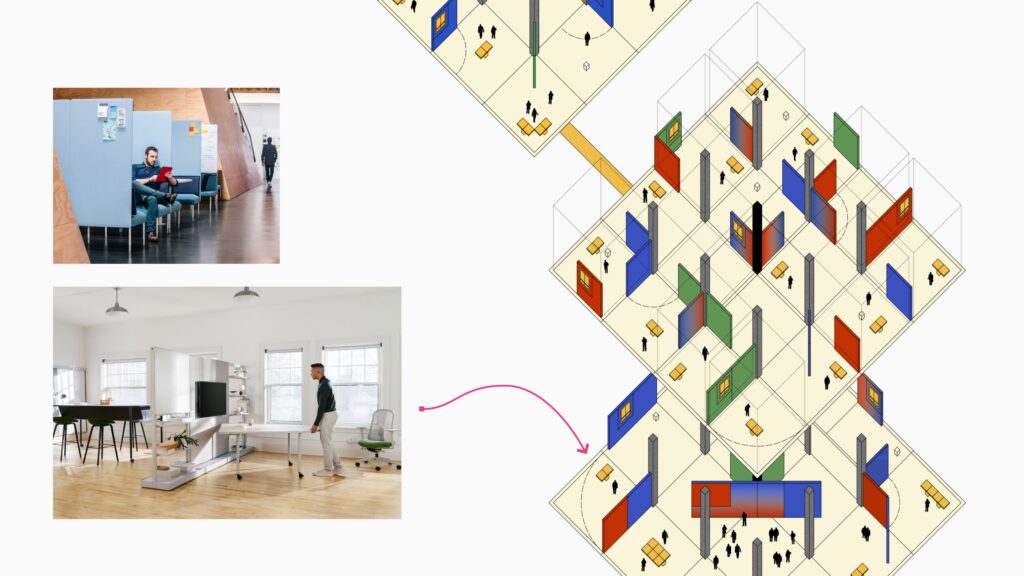
SHIFT 03
From floorplate flexibility to user adaptability
Returning office workers will bring new expectations for user control to the workplace
In the past, a workplace setting was considered “flexible” if it could be reconfigured for different uses by a facilities or maintenance team. As organizations plan their return-to-work strategies, however, the power to adapt a space needs to rest with the people working within it.
Change is always expected whenever any workplace moves from construction to post-occupancy. That said, it has never been tougher for organizations to plan for these changes than now, as employees return from this prolonged experience of working from home. We believe that shifting investments toward furnishings and tools that fit into existing floorplates can optimize space to embrace change. These kinds of adaptable solutions will meet rising expectations for autonomy, choice, and user control.
Key Insights
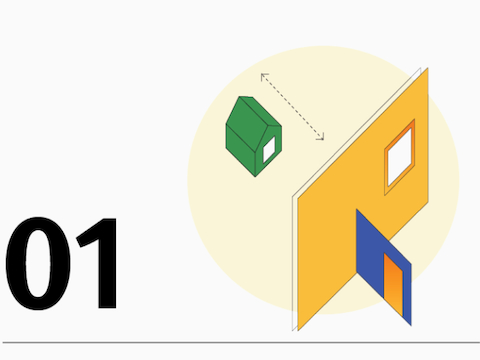
Examine a hybrid approach to workplace strategy
As workers return to the office, many will want to continue to exercise the freedom to work from home at least part-time. Support for that choice should be a key component of every go-forward workplace strategy. Organizations that embrace distributed work in a manner consistent with their culture will ultimately empower their employees with a robust set of choices to create positive, healthy work experiences. Companies can benefit from nurturing a sense of autonomy among their people, as an equitable and inclusive experience is essential for tapping into the productivity of a highly diverse workforce.

Embrace the unique role of the office
The office must prove its value to employees in this new era of autonomy. To do so, office design must focus on those functions that haven’t been successfully supported during this extended work-from-home experiment: establishing and maintaining social culture, supporting longer-duration team activities, and providing spaces for focused work. Ultimately, these changes will make the office more desirable and inclusive.

Empower people with the tools to reshape spaces
To remain a relevant part of the post-pandemic work experience, the office must move beyond flexibility to truly become adaptable. The distinction is subtle but important. When spaces are flexible, they can be reconfigured by a facilities team to support a range of activities. When they are adaptable, they provide a level of individual control, inviting the people who use a space to reshape it around their needs in the moment.
This content is also available on the website: Looking Forward – Herman Miller or as a downloadable PDF to make it easier to read on the go and share with colleagues.
Allison Dvorak, AIA, CPHC, is a member of the AIA South Dakota Board of Directors, liaison to the Emerging Professionals and Communication committees, and an architect in Sioux Falls. She received her M.Arch from North Dakota State University and continues to develop her Master’s thesis of researching and implementing design theories focused on human centered design through speaking engagements, design practice, and one-on-one client education. Allison lives in Sioux Falls with her husband, son and daughter.


